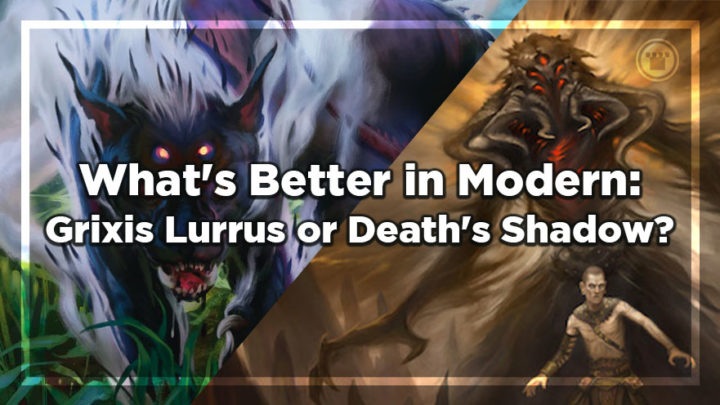Over the last few weeks, there has been a lot of discussion in the Grixis community about whether to include Death’s Shadow in your deck. While many of you can probably guess where I stand on this, I’m here today to present some facts about these two decks and when it’s best to play one over the other. First things first, I believe both of these decks are solid competitive options. But despite sharing a large number of cards, they function differently enough that their individual merits are worth discussing. Let’s break it down!
Grixis Death’s Shadow
I’ve written at length about Grixis Death’s Shadow, and you can find my latest deck guide on it here.

Death’s Shadow functions primarily as a tempo deck that utilizes cheap, powerful cards to leverage a mana advantage. Disruption like Inquisition of Kozilek, Thoughtseize, and Drown in the Loch can keep the opponent off balance long enough for Death’s Shadow and friends to finish the game.
Efficiency is the name of the game for Death’s Shadow; discard and removal spells only work for so long before your opponent can put it back together. Death’s Shadow gives Grixis decks the closing speed they need to end the game before that happens.
Grixis Death’s Shadow has a slightly lower curve than Grixis Lurrus, which allows you to play 1-2 fewer lands, leaving room for more gas. Death’s Shadow is a more proactive strategy than the other Grixis decks, which plays well in faster Modern metagames.
Grixis Lurrus
Grixis Lurrus was popular shortly after the release of Modern Horizons 2, then fell off the map for a while as Jund Saga became the go-to choice for grindy Lurrus decks. Current Grixis Lurrus decks have certainly become more threat dense than the original versions, which at points were only playing Ragavan and Snapcaster Mage. Because it’s difficult to interact with everything in Modern, a higher threat density makes it less likely that something will slip through the cracks, as games will be shorter on average. As Modern gets more powerful, existing in the middle of the spectrum gets harder, which means you need to either be more controlling or more aggressive. Lurrus decks have a much easier time being aggressive than controlling, so this shift in deck building should bring Grixis Lurrus back to the forefront of Modern.
Whether you want to call this version of the deck a midrange deck or a control deck is a bit subjective. Personally, I’d call it a midrange deck, as it’s more proactive than a traditional control deck. And that’s exactly where the line between Grixis Shadow and Grixis Lurrus gets drawn in my eyes. Shadow is looking to end the game by playing threats backed up with disruption, whereas Grixis Lurrus plays disruption backed up with threats. Notably, Grixis Lurrus is more resilient than Grixis Shadow, as they have extra copies of Kroxa and Tourach in the main deck.
Overlapping Cards and Strategies
Grixis Shadow and Grixis Lurrus have a ton of overlapping cards, as there is an established core of powerful Grixis cards that both decks play.
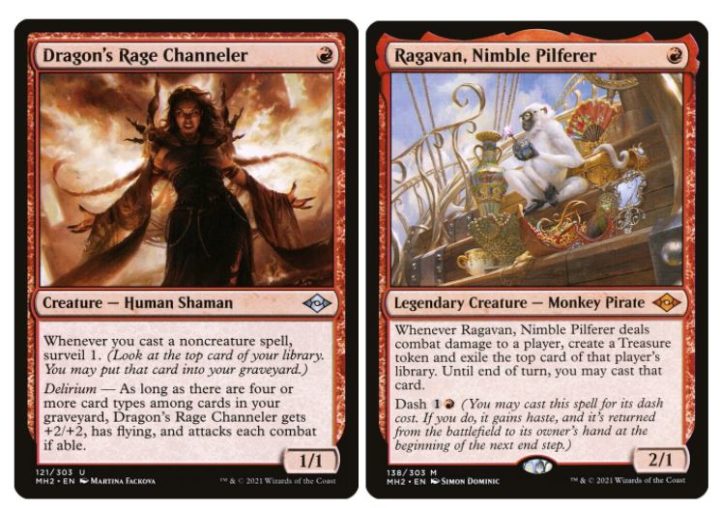
Four copies of both Ragavan and Dragon’s Rage Channeler show up in both decks. These cards provide early pressure as well as low-cost card advantage. If you’re playing any sort of Rakdos-based Lurrus deck, you should have the full eight copies.
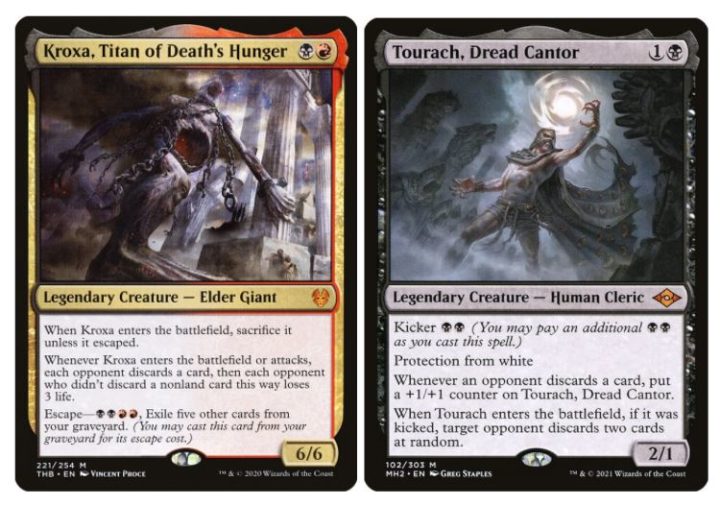
Kroxa and Tourach show up in both decks, too. Grixis Lurrus has two of each in the main deck, where Grixis Shadow has them split between the main deck and the sideboard. These are the threats that allow Lurrus decks to “cheat” on mana, in a sense. They’re both Lurrus-compatible at two mana, but they both function more as four-mana spells if you’re getting the most out of them.
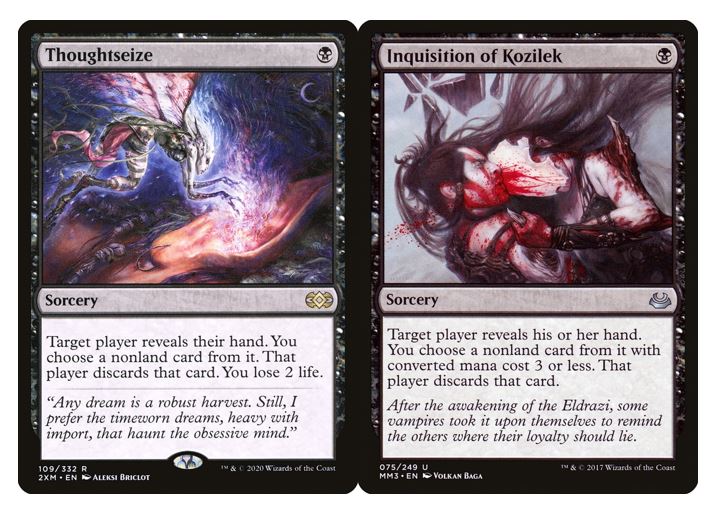
Thoughtseize and Inquisition of Kozilek make both rosters, but the splits are a bit different. Grixis Shadow has 4 Thoughtseize and 2 Inquisition of Kozilek, whereas Grixis Lurrus has 4 Inquisition of Kozilek and 3 Thoughtseize. Both decks are interested in having a discard spell available in the first couple turns in almost every game, but Death’s Shadow wants more copies of Thoughtseize to enable its namesake card. Grixis Lurrus is happy to save a couple life points by casting more copies of Inquisition, and it wants to have a higher density of interaction than Shadow does, which is part of the reason that you’ll find more discard spells in that version.

Unholy Heat, Fatal Push, and Lightning Bolt make up the important suite of one-mana removal spells. In the current Modern metagame, Grixis decks should have at least six removal spells available on turn one to adequately deal with Ragavan when on the draw. Unholy Heat is the best pure removal spell of the bunch that can answer creatures from Ragavan to Primeval Titan, which leads both decks to play the full four copies. Fatal Push has its strengths against Death’s Shadow, Tarmogoyf, and anything holding a Colossus Hammer – all creatures that can grow out of Unholy Heat’s range. Finally, one copy of Lightning Bolt makes the deck as a way to help finish off planeswalkers, small creatures, or your opponent! One of my favorite applications is targeting myself with Lightning Bolt to give my Death’s Shadows a permanent +3/+3.

Mishra’s Bauble and Expressive Iteration show up with the full four copies in both lists. These two comprise a lot of the card selection in Grixis decks. Bauble is a powerful zero-mana option that pairs well with Dragon’s Rage Channeler and Lurrus, to either filter or draw extra cards. Expressive Iteration is simply so powerful on rate that it would be foolish not to play it, given the opportunity.
Both decks feature three copies of Dress Down. Grixis Shadow has two copies in the main deck because it plays well with both Death’s Shadow and Kroxa. Kroxa alone isn’t enough for Grixis Lurrus to play this card in the starting 60, but it makes for an incredibly potent sideboard card, especially against Four-Color Yorion and any deck with Urza’s Saga.
Kolaghan’s Command waxes and wanes in popularity depending on the metagame. Currently, Grixis Lurrus has two copies in the main deck and Grixis Shadow has one, with an additional two in the sideboard. Kolaghan’s Command is a powerful option against Rakdos-based strategies to help grind through removal spells. Hammer Time is another excellent match-up for Kolaghan’s Command, as it is one of the only good instant-speed ways to destroy a Colossus Hammer.
Differences
Aside from Death’s Shadow and sideboard cards, these two decks have an awful lot in common. Where I believe the differences exist is in the match-up spreads. Naturally, when two decks are this similar, a lot of the match-ups are going to be similar as well, so I’ll highlight some specific match-ups that favor one deck over the other.
Amulet Titan
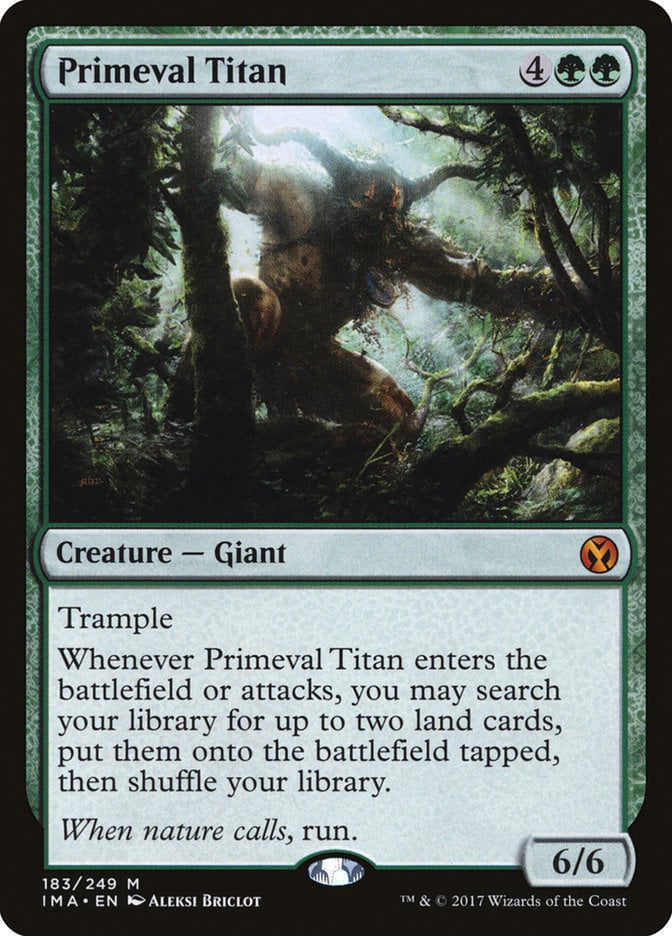
Advantage: Death’s Shadow
I think Amulet Titan clearly favors Death’s Shadow. If you try to fight a removal spell battle with Amulet Titan and Cultivator Colossus, you’re going to lose more often than not. Death’s Shadow allows you to take an aggressive stance, where you can get underneath them while they set up, then swing for lethal with a Death’s Shadow before they recover. Dress Down is one of the best cards that Grixis decks have against Amulet Titan, and Death’s Shadow gets to start two of them in game one. Grixis Lurrus simply can’t end the game fast enough or often enough to avoid getting run over by the Jolly Green Giant.
Burn

Advantage: Death’s Shadow
Burn has a reputation for being a bad match-up for Death’s Shadow, which I don’t believe is true. In my eyes, that match-up is fairly even, maybe narrowly favoring Shadow, depending on how your deck is built. In fact, Death’s Shadow is one of the single most important cards in the match-up from both sides. It dictates the speed and timing at which the Burn player can deploy their spells, and most importantly, it’s the best way that Grixis decks can kill a Burn player in a short amount of time.
Grixis Lurrus doesn’t have the correct types of disruption to hold off Burn for long enough to pick up kills without Shadow. That being said, Dragon’s Rage Channeler and Ragavan both give the Grixis decks a reasonable floor. Grixis Lurrus is slow enough that it turns an otherwise even match-up into a subpar match-up by cutting Death’s Shadow.
Hammer Time
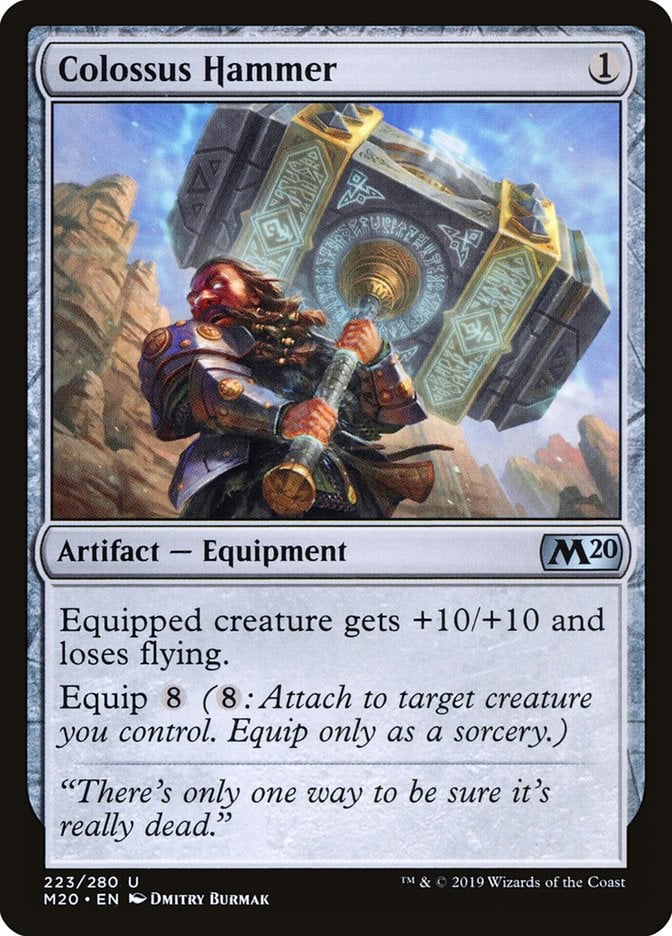
Advantage: Grixis Lurrus
Hammer Time is going to favor Grixis Lurrus. Having access to four copies of Inquisition buffers your life total a bit, which may let you absorb an extra hit or two. A main deck copy of Engineered Explosives and an extra Kolaghan’s Command are also welcome additions.
Four-Color Yorion
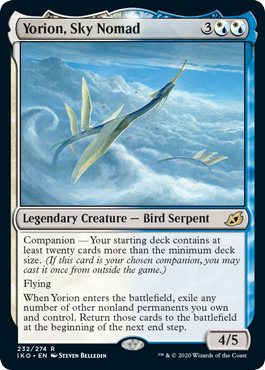
Advantage: Death’s Shadow
Four-Color Yorion might seem like it favors Grixis Lurrus because it is a value oriented match-up. And that’s exactly the problem: in value-centric match-ups, being the slightly smaller value deck is a bad place to be. Grixis Lurrus can grind through Four-Color Yorion, but playing the value game with them is often going to get you buried.
Meanwhile, Death’s Shadow can come out of the gates strong and punish Yorion players for keeping a slower hand that is vulnerable to a Thoughtseize. Solitude may seem like a big deal, but it isn’t as important as people make it out to be. Shadow is starting two copies of Dress Down with a third in the board, and has an extra Thoughtseize to help deal with Solitude. While Grixis Lurrus has one extra copy of Tourach in game one, I don’t think it’s enough to move the needle to favor Grixis Lurrus.
Other RBx Lurrus Decks

Advantage: Grixis Lurrus
Most of the gameplay between RBx Lurrus decks is similar to old school Jund mirrors. Both players trade removal for threats and discard for removal until one player has the last thing standing that wins the game. Grixis Lurrus is better set up for those match-ups with an extra Kroxa, Tourach, and Kolaghan’s Command in the main deck, not to mention some extra life to play with. Snapcaster + Kolaghan’s Command does a ton of work in these match-ups, which often comes down to whose Lurrus lives the longest.
At the end of the day, I think what side of the “Shadow vs. no Shadow” debate you fall on will largely come down to personal preference, as both decks are viable. However, if you want to maximize your equity against an expected field, I suggest sitting down and analyzing some of the most common match-ups. If I were playing a large open tournament, like a Grand Prix, I’d favor the more proactive deck. So, unless the metagame were particularly hostile toward Death’s Shadow, that would be my choice. After all, you don’t need to control your opponent for as long if you just end the game.
I hope this guide was helpful for any Grixis mages who may be unsure what to sleeve up for an upcoming event. I’ll be back next week with more Modern content! As always, you can find me on Twitter at @RappaciousOne for questions or comments.

Michael Rapp is a Modern specialist who favors Thoughtseize decks. Magic sates his desire for competition and constant improvement.

